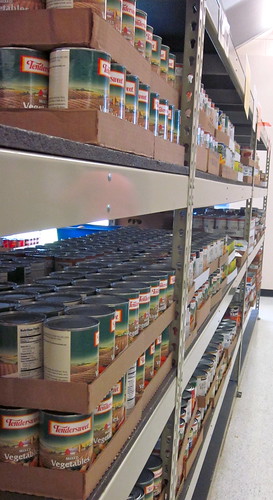I attended a community meeting a couple weeks ago for an organization called Hunger Free Colorado. They are the lobbying arm of the Feeding America-fueled food banks in the state. They take direction from the five food bank leaders state-wide on what to lobby with local, state and federal officials to better meet the needs of hungry Coloradans.
In Arizona, the Association of Arizona Food Banks handles this responsibility. The director, Ginny Hildebrand, is a force to reckon with. She is savvy, kind and damn effective. I had a chance to go to Washington DC with her once on a lobbying trip and that woman moves mountains.
As a food pantry volunteer, I was interested to hear about the systemic changes that this organization is working on for the state. I’d noticed more and more families coming into the pantry who were seeking sustainable food assistance. I’ve had this nagging concern the system at hand is failing because our “emergency” food boxes were becoming routine.
Something is obviously broken, and I’m no expert in any aspect of the policial or practical system of getting food to hungry folk. That said, any volunteer would notice many of the families coming to the pantry are stuck in a “job of being poor.” It takes a lot of time to access most basic public health services to keep a family fed. This may include visiting a food pantry or more per week — which is typically an all day affair when you are on the city bus.
If you’ve ever spent a day in a food bank, you realize there are far too many ways things could be better.
For example, how about these statistics:
- 1/4 of families in Colorado report not having enough food, via a Gallup poll
- The typical recipient of “food stamps” (called SNAP in Colorado) are a family of 4 living on less than $12,000 per year.
- The application for SNAP, until recently, was 26 pages long. On page 4, the applicant was asked if he/she spoke/read English. Apparently up until then, they were expected to intuitively know what they were being asked.
- While more than $500,000,000 has been spent on Colorado’s SNAP and food assistance software system since 2004, it doesn’t work. The state of Maine spent $15,000,000 on theirs and it works fantastically. There is little political motivation here to change what exists, even though it doesn’t work and hunger experts testified to the fact beforehand, “because we don’t want to spend more money.” (To me that’s like not repairing the navigation system in the Titanic because the deck furniture cost too much. The system isn’t sinking. It sunk.)
- All this said and done, the average Colorado family is on SNAP for less than 10 months.
It is daunting and entirely overwhelming to consider lobbying political issues, and yet — we are bucket brigading a huge fire that will consume Colorado if we don’t stop to install a fire department instead. (Not my analogy — one I heard in the meeting that I thought was rather apt.) And so, we continue bucketing as fas as we can and somehow muster the spirit and energy to create bigger, better change that stops the fire from starting.
I have to believe the basic steps we — those who don’t need food assistance — can all take, no matter where we live, look a bit like this:
1. Invite a friend over with a similar passion, or grab your roommate/spouse, and visit your neighbors. Go to each door around the block and introduce yourself. Take mental notes. Chances are, 1 in 4 of those houses you visit are hungry.
2. Invite your neighbors over for a potluck/bbq. Make it welcoming for those who can’t bring food, and get to know who these folk are. Chances are, you won’t like them all. And chances are, you’ll really like some of them. With certainty, the type of change I’m encouraging requires having civil conversations with both and recognizing public health issues — like hunger — don’t discriminate.
3. Plant a garden. Harvest it for yourself, your neighbors and your community food pantry.
4. If you can give time, volunteer. If you want to give to the food pantry — give money. They can typically buy 10 times what the average consumer can with the same amount of money.
5. Vote. Talk to local, state and federal politicians about how hunger is influencing your neighborhood. Make it tangible with stories you’ve heard and your experiences. For those in Denver, the way to communicate with such officials can be found here, here and here.
~K



